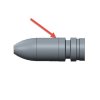different powders do coat to a different thickness.
the amount of tin you have in the alloy will also influence how much powder the bullet takes.
think about putting bondo on a cars fender, a heavier gouging weight sandpaper allows more surface area for the bondo to grab onto.
Huh... had not known that. Makes sense, this alloy I'm using when I cast my NOE 70gr had about .5% more tin than I usually put in. Bullets came out with a little more... crystalization effect when light bounces off of it. That's the best way I can visually explain it. And yes, a bit more rough to the touch. I have noticed that these were coating a little bit thicker.
@Ian Nice looking groups, at least to me. That's about the best I have gotten so far in my quest, and it's with no consistency. I get those about 1 in 20 of the time. If I were able to shoot 1.25 groups with consistency, I would be done with this project. The load is for 100 yard CMP high power practice at the local sports club. Shooting with iron sights. So 1.25 would be great for me. I'm optimistic I can get there

So now onto some measurements of the chamber side and muzzle side.
not having done it with this method before, I may have measured in the wrong area, but here is a pic of where I measured the land engravings on the chamber side:

Normally I would do the pound cast method where you insert a cartridge with a slug that is a few thousands less that bore size, close the bolt, and whack a brass rod down the barrel so the slug expands to the dimensions of the first 1/2 of the barrel on back to the throat and such.
Here are the measurement results from the land engravings on the chamber side (C = control/unmolested)
- Green 1 - 219.5
- Green 2 - 221.5
- Green 3 - 219.5
- Green 4 - 219.5
- Green C - 223.5
- Blue 1 - 221.5
- Blue 2 - 221.0
- Blue C - 224.5
Measurements from the muzzle side:
- Muzzle 1 - 219.5
- Muzzle 2 - 219.5
Also, here are some pics. (I am bad at editing and resizing)
There you have it. Not sure if I am measuring in the right spot, I'd appreciate guidance if I am off.







